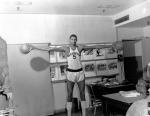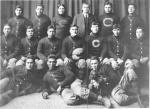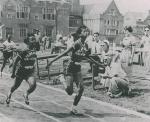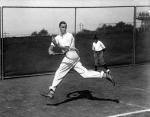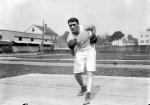Chapter 1: The Quest for Records and Titles
"Citius. Altius. Fortius." Those three little words –"swifter, higher, stronger," the motto of the modern Olympic Games embrace the essence of what sports are about and why athletes push themselves to compete. Perhaps they are embedded in our genetic make-up, for there hardly seems a time when men and women were not set on using their bodies to prove something about their potential. From the mists of sport's primal beginnings, the reason that we face off and challenge each other on the playing field instead of the battle field has been the same: to determine who is better on a given day. Who is faster? Who is stronger?
Sometimes the quest for the answer manifests itself in a record, sometimes in a title. Sometimes it is fueled by human power alone, sometimes by powers outside ourselves, sometimes by powers we have built with our own hands. Sometimes the quest is entered into simply for the satisfaction of the achievement itself, sometimes for the fame and fortune that accompanies the attainment.
For generations, NBA superstars have chased, but only once come within twenty points of Wilt Chamberlain's seemingly unapproachable 1962 standard of
Wilt Chamberlain's seemingly unapproachable 1962 standard of  100 points in a single game. As dominating as any player ever to pick up a basketball, Chamberlain, who grew up in Philadelphia and later played for both the Philadelphia Warriors and the Philadelphia 76ers, averaged an unearthly fifty points a game that year. All these years later, he still owns six of the top ten single-game scoring marks in league history. One of basketball's first true giants, his achievements still tower over the game he revolutionized.
100 points in a single game. As dominating as any player ever to pick up a basketball, Chamberlain, who grew up in Philadelphia and later played for both the Philadelphia Warriors and the Philadelphia 76ers, averaged an unearthly fifty points a game that year. All these years later, he still owns six of the top ten single-game scoring marks in league history. One of basketball's first true giants, his achievements still tower over the game he revolutionized.
A track star in high school, Chamberlain joined the long chain of participants – including sprinter Walter Tewkesbury, an early Olympic champion, and the multi-talented
Walter Tewkesbury, an early Olympic champion, and the multi-talented  Jim Thorpe, the football legend and Olympian considered the greatest overall athlete of the first half of the twentieth century–to take part in the
Jim Thorpe, the football legend and Olympian considered the greatest overall athlete of the first half of the twentieth century–to take part in the  Penn Relays, the world's largest and longest-running track meet.
Penn Relays, the world's largest and longest-running track meet.
Though track and field is a marquee event in any Olympic games, no Olympian in any sport made a bigger splash than Windber's Johnny Weissmuller. Before swinging to movie fame as Hollywood's most successful Tarzan, he burned up the swimming pool in the 1920s. The first swimmer to break the one-minute barrier in the 100-meter freestyle, he went on to win five Olympic gold medals, and fifty-one national titles. In the process, he set sixty-seven world records.
Johnny Weissmuller. Before swinging to movie fame as Hollywood's most successful Tarzan, he burned up the swimming pool in the 1920s. The first swimmer to break the one-minute barrier in the 100-meter freestyle, he went on to win five Olympic gold medals, and fifty-one national titles. In the process, he set sixty-seven world records.
Swimming was one of the few international sports open to women in those years. Playing fields as a whole remained unlevel until 1975, when Commonwealth Court Judge Genevieve Blatt upheld the controversial provisions of Title IX that finally gave girls equal access to school sports. Still, there were coaches who could recognize talent, and young women burning to display the talent they had. In the 1920s and 1930s, the two intersected dramatically at the
Genevieve Blatt upheld the controversial provisions of Title IX that finally gave girls equal access to school sports. Still, there were coaches who could recognize talent, and young women burning to display the talent they had. In the 1920s and 1930s, the two intersected dramatically at the  Homestead Library Athletic Club, a remarkable community center funded by Andrew Carnegie in a gritty Pittsburgh mill town. Under the tutelage of coach Jack Scarry, the Homestead's women's swim team won a host of national titles. Four of its best swimmers also competed in a trio of Olympics, winning five medals, two of them gold. Meanwhile, in York, another coach,
Homestead Library Athletic Club, a remarkable community center funded by Andrew Carnegie in a gritty Pittsburgh mill town. Under the tutelage of coach Jack Scarry, the Homestead's women's swim team won a host of national titles. Four of its best swimmers also competed in a trio of Olympics, winning five medals, two of them gold. Meanwhile, in York, another coach,  Bob Hoffman, began muscling his way into the international arena and began to lead America's best weightlifters to national, world, and Olympic glory.
Bob Hoffman, began muscling his way into the international arena and began to lead America's best weightlifters to national, world, and Olympic glory.
If the door into the sporting arena before 1975 was barely ajar for women, what must it have been like for an African-American woman? And what if the sport that the woman wanted to play was tennis, the preserve of the elite white country clubs? Philadelphian Bill Tilden could at least hide his homosexuality on the center courts at Wimbledon and Forest Hills en route to becoming the best American tennis player of the first half of 1900s; Germantown's Ora Washington could not hide her skin. But she couldn't suppress her drive or ability, either. In the alternate universe of black sports that existed separately and unequally for far too long, she was the undisputed queen of women's tennis, monopolizing the national singles crown from 1929-1936. Her success encouraged the Roosevelt administration, as part of Depression-era work and recovery programs, to build hundreds of public tennis courts in urban areas where the game was unfamiliar.
Ora Washington could not hide her skin. But she couldn't suppress her drive or ability, either. In the alternate universe of black sports that existed separately and unequally for far too long, she was the undisputed queen of women's tennis, monopolizing the national singles crown from 1929-1936. Her success encouraged the Roosevelt administration, as part of Depression-era work and recovery programs, to build hundreds of public tennis courts in urban areas where the game was unfamiliar.
While those tennis courts were going up, boxing clubs and arenas were already staples in urban neighborhoods and in most mill, factory, and mining towns throughout the state. Pennsylvania outlawed boxing in 1867, but local clubs helped restore its air of sporting legitimacy. Wherever there were young Irishmen, Italians, Germans, Poles, Jews, African-Americans–or anyone else–intent on using their fists to earn a few extra dollars and maybe, if all fell their way, a shot at a better life, you could find a club beckoning to them to lace up the gloves. Many club alumni, including Harry Greb, Jack O'Brien, Billy Conn, Tommy Laughran, Battling Levinsky, Joey Giardello, and Joe Frazier, punched their way from obscurity to world championships. And while the club tradition is no longer as vibrant as it once was, it is still on display at venues like Philadelphia's
Tommy Laughran, Battling Levinsky, Joey Giardello, and Joe Frazier, punched their way from obscurity to world championships. And while the club tradition is no longer as vibrant as it once was, it is still on display at venues like Philadelphia's  Legendary Blue Horizon.
Legendary Blue Horizon.
At its best, boxing is never just about power; it is also about speed, and the two together–harnessing the former to increase the latter–have presented an irresistible sporting challenge. Horse racing goes back in Pennsylvania to the earliest colonists; even William Penn ran his fastest horses down Philadelphia's Sassafras Street (since renamed Race Street). Though Pennsylvania outlawed flat-racing early in the 1800s, it did not disappear. Pittsburgh's Stephen Foster captured its appeal in his immortal 1850 song about the Camptown Races. Trotting races, on the other hand, the state did allow, and were so popular that they became drawing cards for the
Camptown Races. Trotting races, on the other hand, the state did allow, and were so popular that they became drawing cards for the  York Inter-state Fair and other annual agricultural fairs held throughout the state. And while racing today is neither as popular nor as glamorous as it once was, a trio of twenty-first century horses with Pennsylvania connections–Smarty Jones, Afleet Alex, and Barbaro–all reached beyond racing to become sporting heroes to the public at large.
York Inter-state Fair and other annual agricultural fairs held throughout the state. And while racing today is neither as popular nor as glamorous as it once was, a trio of twenty-first century horses with Pennsylvania connections–Smarty Jones, Afleet Alex, and Barbaro–all reached beyond racing to become sporting heroes to the public at large.
Of course, the human need for speed extends beyond sinew and muscle. In the early 1800s, Philadelphia and Pittsburgh became national centers for competitive rowing, which for decades reigned as one of the state's most popular spectator sports. When a series of new inventions and manufacturing techniques made the bicycle more accessible to the masses in the late 1800s, racing bicycles naturally followed. Indeed, for awhile bicycle racing was second only to baseball in America's heart as both a competitive and recreational sport. One of the nation's most popular and accomplished riders was Erie's
rowing, which for decades reigned as one of the state's most popular spectator sports. When a series of new inventions and manufacturing techniques made the bicycle more accessible to the masses in the late 1800s, racing bicycles naturally followed. Indeed, for awhile bicycle racing was second only to baseball in America's heart as both a competitive and recreational sport. One of the nation's most popular and accomplished riders was Erie's  Otto Maya, a specialist in endurance events. Pedal power, however, had no chance against the horsepower produced by the internal combustion engine. By the 1930s, some of the best auto racing in the nation was on display at the
Otto Maya, a specialist in endurance events. Pedal power, however, had no chance against the horsepower produced by the internal combustion engine. By the 1930s, some of the best auto racing in the nation was on display at the  Langhorne Speedway. Today, the enormously popular NASCAR circuit stops annually at the Pocono International Raceway.
Langhorne Speedway. Today, the enormously popular NASCAR circuit stops annually at the Pocono International Raceway.
There are the teams, too, at every level, that somehow blended together disparate personalities and talents to work as one, like the 2005 Steelers, the "We Are Family" Pirates and the "Broad Street Bullies" Flyers of the 1970s, the fierce national championship college footballers from Pitt and Penn State, and the improbable squad from Villanova – one of the Philadelphia Big 5 – that shocked the 1985 NCAA basketball tournament by taking home the crown.
Which brings us back to Wilt Chamberlain. He was so good, he didn't need much support to lead Overbrook High School to city championships in 1954 and 1955, He did, however, have to revamp his approach to the game, a decade later, to accommodate his teammates as a professional before he could win another. A championship meant that much to him.
Sometimes the quest for the answer manifests itself in a record, sometimes in a title. Sometimes it is fueled by human power alone, sometimes by powers outside ourselves, sometimes by powers we have built with our own hands. Sometimes the quest is entered into simply for the satisfaction of the achievement itself, sometimes for the fame and fortune that accompanies the attainment.
For generations, NBA superstars have chased, but only once come within twenty points of
A track star in high school, Chamberlain joined the long chain of participants – including sprinter
Though track and field is a marquee event in any Olympic games, no Olympian in any sport made a bigger splash than Windber's
Swimming was one of the few international sports open to women in those years. Playing fields as a whole remained unlevel until 1975, when Commonwealth Court Judge
If the door into the sporting arena before 1975 was barely ajar for women, what must it have been like for an African-American woman? And what if the sport that the woman wanted to play was tennis, the preserve of the elite white country clubs? Philadelphian Bill Tilden could at least hide his homosexuality on the center courts at Wimbledon and Forest Hills en route to becoming the best American tennis player of the first half of 1900s; Germantown's
While those tennis courts were going up, boxing clubs and arenas were already staples in urban neighborhoods and in most mill, factory, and mining towns throughout the state. Pennsylvania outlawed boxing in 1867, but local clubs helped restore its air of sporting legitimacy. Wherever there were young Irishmen, Italians, Germans, Poles, Jews, African-Americans–or anyone else–intent on using their fists to earn a few extra dollars and maybe, if all fell their way, a shot at a better life, you could find a club beckoning to them to lace up the gloves. Many club alumni, including Harry Greb, Jack O'Brien, Billy Conn,
At its best, boxing is never just about power; it is also about speed, and the two together–harnessing the former to increase the latter–have presented an irresistible sporting challenge. Horse racing goes back in Pennsylvania to the earliest colonists; even William Penn ran his fastest horses down Philadelphia's Sassafras Street (since renamed Race Street). Though Pennsylvania outlawed flat-racing early in the 1800s, it did not disappear. Pittsburgh's Stephen Foster captured its appeal in his immortal 1850 song about the
Of course, the human need for speed extends beyond sinew and muscle. In the early 1800s, Philadelphia and Pittsburgh became national centers for competitive
There are the teams, too, at every level, that somehow blended together disparate personalities and talents to work as one, like the 2005 Steelers, the "We Are Family" Pirates and the "Broad Street Bullies" Flyers of the 1970s, the fierce national championship college footballers from Pitt and Penn State, and the improbable squad from Villanova – one of the Philadelphia Big 5 – that shocked the 1985 NCAA basketball tournament by taking home the crown.
Which brings us back to Wilt Chamberlain. He was so good, he didn't need much support to lead Overbrook High School to city championships in 1954 and 1955, He did, however, have to revamp his approach to the game, a decade later, to accommodate his teammates as a professional before he could win another. A championship meant that much to him.





